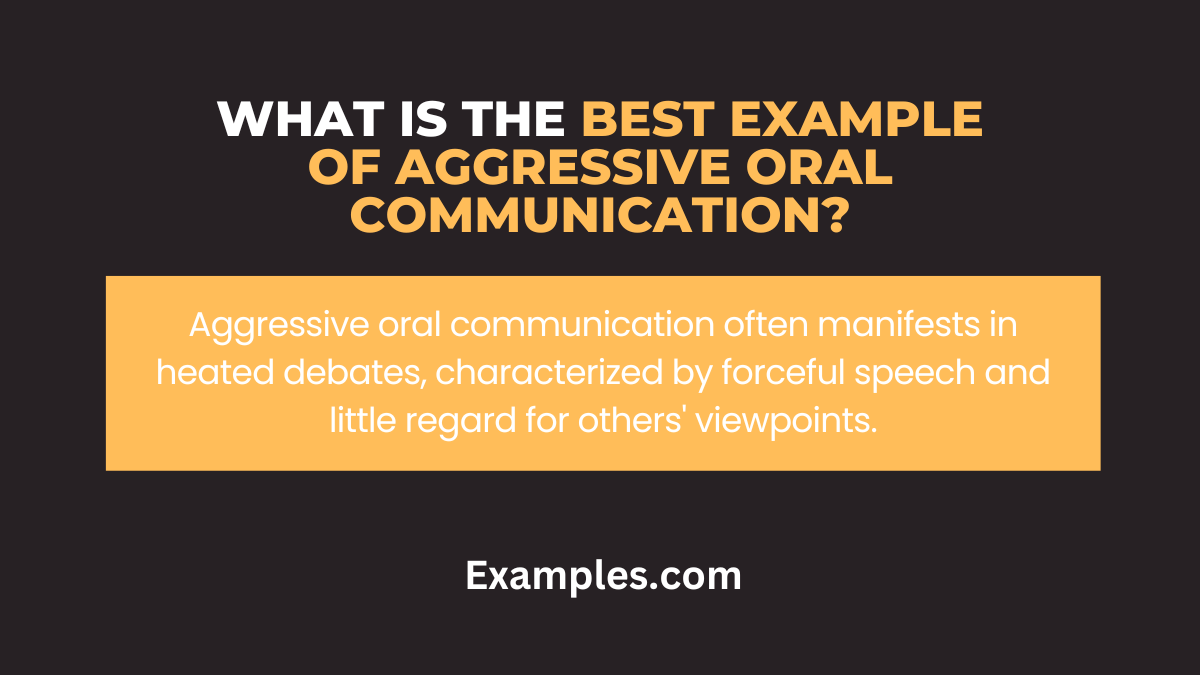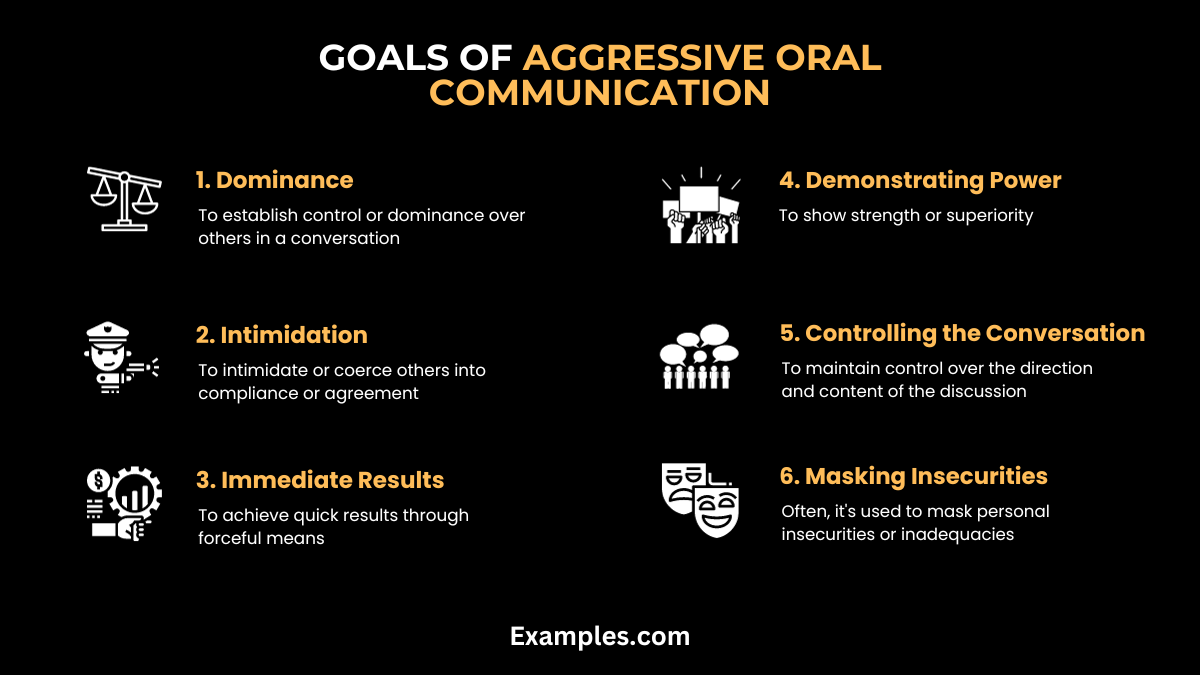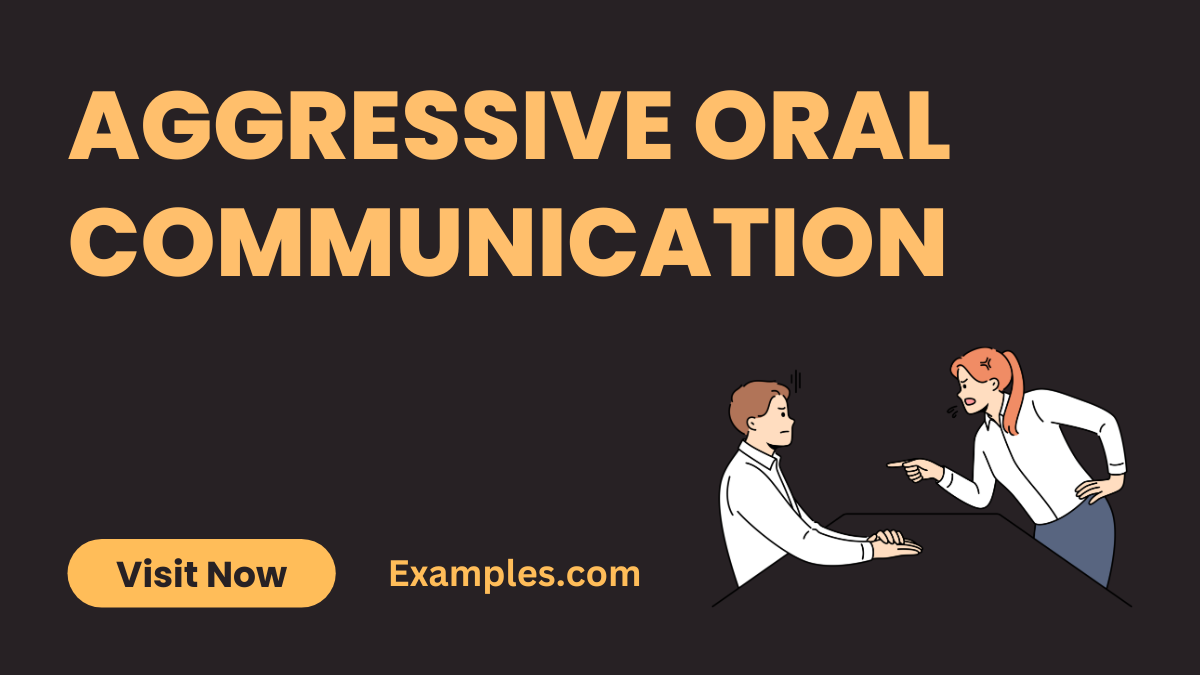Aggressive Oral Communication
Aggressive oral communication often involves assertive language and a dominant tone, which can be both effective and challenging. This guide explores various communication examples where aggressive communication plays a key role, providing insights on how to use this style effectively. While often perceived negatively, when used appropriately, aggressive communication can be a powerful tool in negotiations, debates, and leadership scenarios. Understanding the nuances and impact of this communication style is crucial for anyone looking to sharpen their oral communication skills.
What is Aggressive Oral Communication?

Aggressive oral communication is characterized by a forceful, assertive, and often direct style of speaking. It typically involves conveying one’s message in a way that can be perceived as blunt, commanding, or even confrontational. This form of communication often focuses on the speaker’s needs and opinions, sometimes at the expense of others’. It is essential to distinguish aggressive communication from assertive communication, which is more about being firm yet respectful.
What is the Best Example of Aggressive Oral Communication?

The best example of aggressive oral communication is often found in high-stakes negotiations or debates, where individuals assert their positions forcefully and unyieldingly. This can include raising one’s voice, using strong and sometimes accusatory language, and exhibiting a dominant posture. In such scenarios, the speaker leaves little room for dialogue or consideration of others’ viewpoints, focusing instead on winning the argument or imposing their perspective. While this can be effective in certain situations, it also risks alienating the audience or escalating conflicts.
Aggressive oral communication is characterized by a confrontational, often hostile tone that can undermine effective interaction. Such communication usually includes a lack of active listening in oral communication and fails to understand in oral communication. It’s marked by its intensity and the emotional charge, often leading to miscommunication and conflict. Aggressive communicators tend to dominate conversations, disregard others’ opinions, and prioritize their own needs and thoughts. This approach to communication can be damaging to both personal and professional relationships, as it fosters a negative and unproductive environment.
Examples of Aggressive Oral Communication
Aggressive oral communication is marked by assertiveness taken to an extreme, often leading to confrontational and dominating interactions. This communication style, while sometimes effective in specific contexts, can create tension and hinder cooperative dialogue. The examples below highlight various forms of aggressive communication, showcasing how forceful language, tone, and demeanor can overpower a conversation, often at the expense of collaborative understanding and respect.
- “Do it my way, it’s the only right way.” This statement leaves no room for alternative perspectives, asserting dominance and dismissing others’ input.
- “I don’t care what you think, this is what we’re doing.” Exhibits disregard for others’ opinions, emphasizing control over collaboration.
- “You’re wrong, and here’s why.” Immediately discredits another person’s viewpoint, establishing a confrontational stance.
- “That’s the stupidest idea I’ve ever heard.” Uses derogatory language to belittle and dismiss another’s contribution.
- “Shut up, I’m speaking now.” Aggressively demands attention, disrespecting others’ right to speak.

- “You just don’t get it, do you?” Patronizing tone, implying superiority over the listener.
- “I’m not interested in your excuses.” Cuts off communication, refusing to acknowledge others’ explanations.
- “It’s my way or the highway.” Presents an ultimatum, leaving no space for negotiation or compromise.
- “I don’t need your advice.” Rejects input assertively, indicating self-sufficiency and dismissal of others.
- “Just stop talking; you’re making it worse.” Abruptly silences others, indicating intolerance and impatience.
- “You have no idea what you’re talking about.” Directly challenges the other’s knowledge or competence.
- “I won’t repeat myself again.” Asserts authority, implying frustration and impatience.
- “I’ll handle this because you obviously can’t.” Undermines another’s abilities, asserting control.
- “I’m in charge, so you’ll listen to me.” Establishes dominance based on hierarchical status.
- “Don’t question me; I know what I’m doing.” Refuses to be challenged, asserting absolute certainty.
- “That’s not a request, it’s an order.” Uses commanding language, eliminating any notion of choice.
- “You’ll do as I say.” Direct and authoritarian, leaving no room for discussion.
- “You’re lucky I’m even considering this.” Implies condescension and a favor being granted.
- “Don’t waste my time with that nonsense.” Dismisses another’s contribution as irrelevant or trivial.
- “You’re either with me or against me.” Polarizes positions, creating an adversarial environment.
- “I don’t want to hear another word.” Abruptly shuts down further dialogue or dissent.
- “Your opinion doesn’t matter here.” Openly disregards and devalues another’s perspective.
- “That’s not up for debate.” Closes off any possibility of discussion or disagreement.
- “I’m not here to make friends.” Indicates a sole focus on objectives, disregarding interpersonal relations.

- “This conversation is over.” Asserts control over the interaction’s conclusion.
- “I don’t need to explain myself to you.” Refuses transparency or accountability in communication.
- “This is pointless; you’re not listening.” Assumes a defensive stance, implying the other’s failure to understand.
- “I’ve heard enough; your turn is over.” Dominates the conversation, controlling speaking turns.
- “Stop trying to argue with me; it’s futile.” Discourages dissent, implying futility in challenging the speaker.
- “You’ll regret not listening to me.” Implies consequences for not adhering to the speaker’s directives.
How Aggressive Communication Damages Relationships?
- Erodes Trust: Aggressive communication often leads to a breakdown in trust, as it can make others feel unsafe or undervalued in the relationship.
- Creates Fear and Intimidation: This style can instill fear, preventing open and honest dialogue.
- Hinders Problem-Solving: Aggressiveness overshadows rational thinking, impeding constructive problem-solving.
- Damages Self-Esteem: Regular exposure to aggressive communication can negatively impact individuals’ self-esteem.
- Leads to Misunderstandings: Aggressive tones can distort the message, leading to misunderstandings.
- Promotes Conflict: Such communication often escalates conflicts instead of resolving them.
- Breaks Down Communication Channels: It can cause others to shut down or withdraw, hindering effective communication.
- Impacts Mental Health: Consistent aggressive interactions can lead to anxiety and stress.
- Reduces Collaboration: Aggression in communication can deter teamwork and collaboration.
- Damages Long-Term Relationships: Over time, this communication style can irreparably damage personal and professional relationships.
What are the Goals of Aggressive Oral Communication?

- Dominance: To establish control or dominance over others in a conversation.
- Intimidation: To intimidate or coerce others into compliance or agreement.
- Expressing Anger or Frustration: To vent personal anger or frustration.
- Immediate Results: To achieve quick results through forceful means.
- Overpowering Opposition: To overpower or silence opposing viewpoints.
- Demonstrating Power: To show strength or superiority.
- Avoidance of Vulnerability: To avoid showing vulnerability or weakness.
- Controlling the Conversation: To maintain control over the direction and content of the discussion.
- Creating Fear: To create a sense of fear or submission in others.
- Masking Insecurities: Often, it’s used to mask personal insecurities or inadequacies.
What are the Impacts of Aggressive Oral Communication?
- Psychological Distress: It can cause anxiety, stress, and lower self-esteem in recipients.
- Harmful Work Environment: Creates a toxic and unproductive workplace atmosphere.
- Social Isolation: Aggressive communicators often find themselves socially isolated.
- Impaired Decision Making: It can lead to rushed or poor decision-making processes.
- Reduced Team Efficiency: Diminishes team morale and collaboration.
- Negative Reputation: Can lead to a negative personal or professional reputation.
- Legal Consequences: In extreme cases, it can result in legal actions for harassment or abuse.
- Health Issues: Chronic aggression in communication can lead to health problems due to stress.
- Reduced Problem-Solving Skills: Aggression hinders creative and effective problem-solving.
- Escalation of Conflicts: Can escalate minor issues into major conflicts.
What are the Benefits of Aggressive Oral Communication?
While aggressive communication is generally viewed negatively, it can sometimes have advantages in very specific contexts:
- Quick Decision Making: In emergency situations, it can lead to quick decision-making.
- Clear Expectations: It can communicate expectations unambiguously, though often at a high social cost.
- Asserting Authority: In some leadership scenarios, it might temporarily establish control.
- Conflict Resolution: In rare cases, it can break a deadlock in arguments (although it’s not an ideal approach).
- Crisis Management: Can be effective in crisis situations where immediate, decisive action is needed.
- Protecting Personal Boundaries: Aggression might sometimes be used to protect personal boundaries in extreme situations.
- Highlighting Seriousness: It can underscore the seriousness of a situation or issue.
- Gaining Attention: Can be effective in gaining attention in noisy or chaotic environments.
- Motivating Action: In some instances, it may motivate others to act quickly, especially in high-stakes situations.
- Defense Mechanism: Serves as a defense mechanism in confrontational or threatening scenarios.
Aggressive oral communication, while effective in specific scenarios like negotiations and leadership, can often lead to negative outcomes. It’s characterized by a forceful and commanding style, which, if unchecked, can erode trust, create fear, and damage relationships. Understanding the fine line between assertiveness and aggression is crucial. Aggressive communication should be employed cautiously, with an awareness of its potential impacts on interpersonal dynamics and the work environment.
For those seeking to understand more about this fine balance and the psychological underpinnings of aggressive communication, the American Psychological Association (APA) offers valuable resources. Additionally, the University of California, Berkeley provides insightful research and articles on communication styles and their effects on personal and professional relationships.



